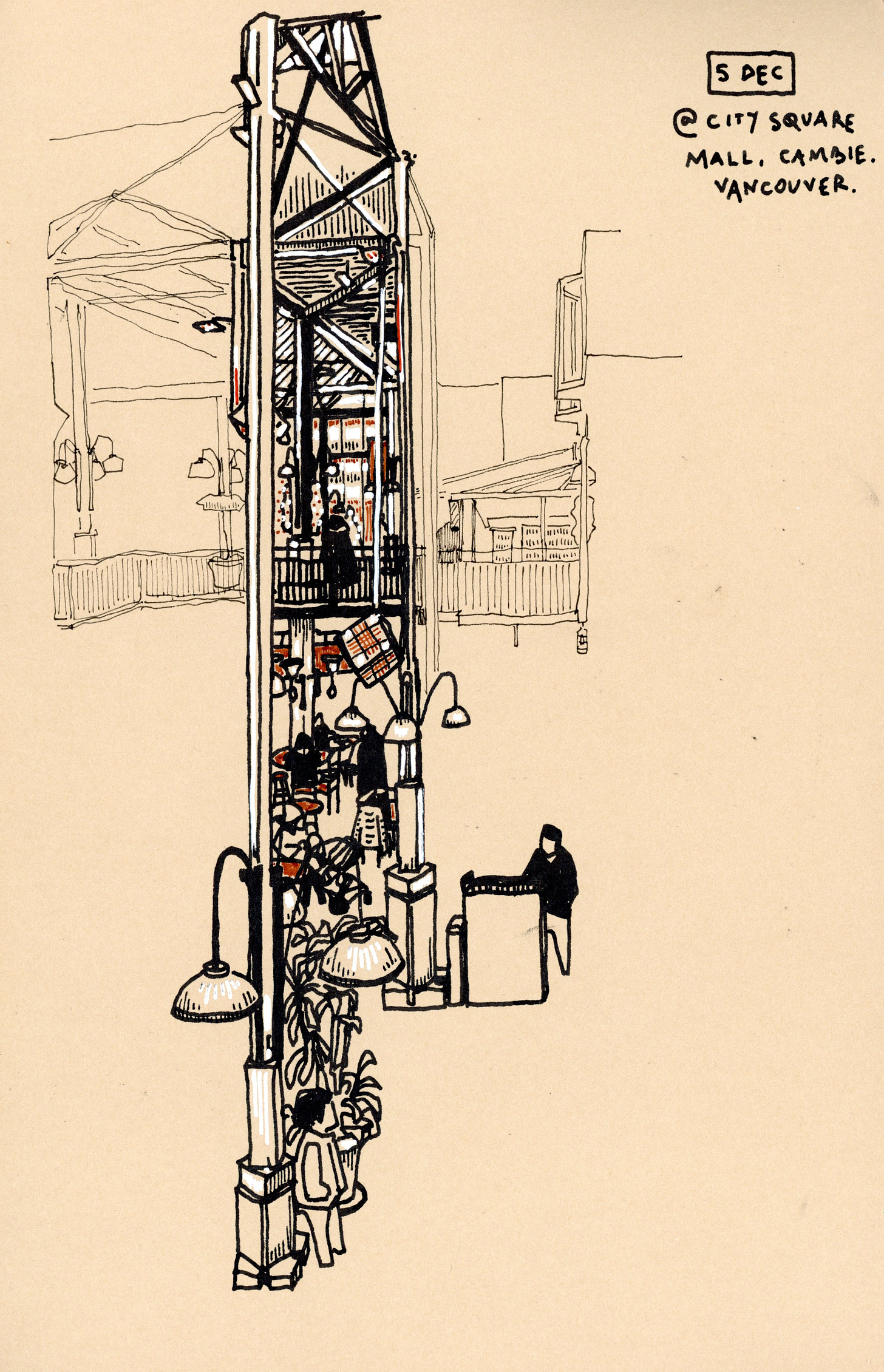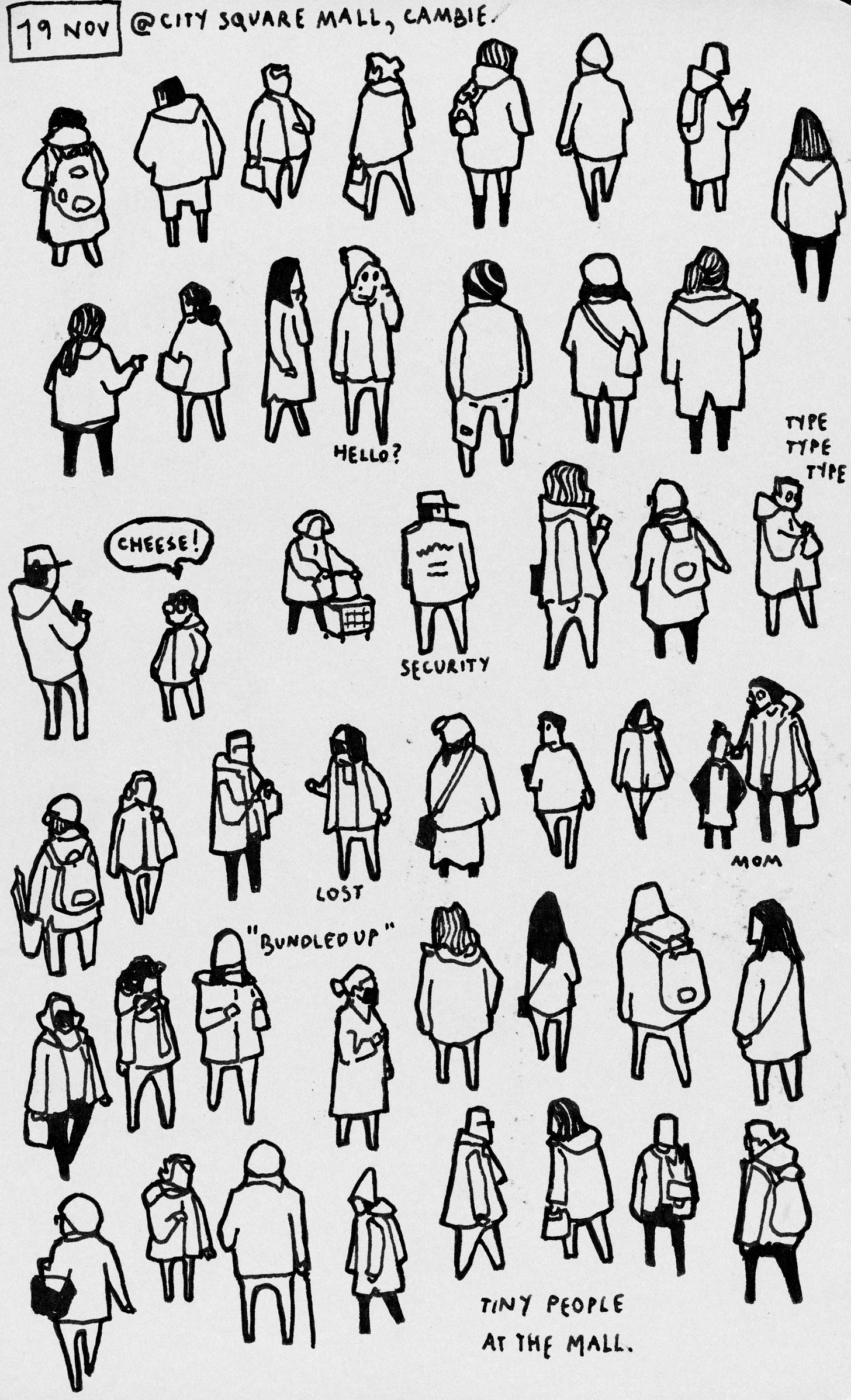Dear reader,
I went to the mall to find answers to this question -
Who goes to the mall anymore?
In today’s post, some answers from a sliver of life, and a matter of perspective from City Square Shopping Center in Vancouver.
Sliver (n)
a long slender piece cut or torn off.
I looked inside a sliver of reality, in the narrow space and time between two pillars, for signs of life.
An elderly lady shuffled towards the exit. A young mother played with her infant. A man deposited his tray on the counter. Another man waited for his food order. In the reflected light of a tall Christmas tree, all manner of life carried on its business.
🎙 Related Listening
Ep 495 of the 99% Invisible Podcast - “Meet us by the Fountain”
From this episode, I learned that malls were designed in America by an Austrian immigrant to recreate “the charms of public life in Vienna.” Nearly 100 years ago, the immigrant Victor Gruen had the same yearning as me - to find a space where people could meet other people, where lives would intersect, and where good coffee was to be found.
Malls came to my hometown of Kolkata (India) in the late 90s. It was a good time. I had just entered my teens. It was also a time of great economic progress. More and more malls appeared every year, and commerce imposed cultural change in its inimitable, inevitable manner. Suddenly, it became possible for young people to find refuge from the blazing heat of summer and hang out in safe, indoor spaces. While malls were a new development, there used to be benches on every floor. One day, the benches were taken away because the teenagers never got off them. (Teenagers like me.)
This happened around the same time that cafes became a thing. To begin, the idea of going out to have coffee was considered utterly ridiculous. My part of the world is all about chai. But a new cafe chain took India by storm because it realized that it was about more than just the coffee.
The tagline of Cafe Coffee Day was this - “A lot can happen over coffee.” As young people trying to meet other young people, we certainly hoped so.
With commerce and social interaction shifting from physical spaces to our screens, it is the idea of public life that keeps malls alive.
Dear reader, does your part of the world have a thriving public life? Have you witnessed mall culture evolve? Share your thoughts.
🔍 Last week, I began my yearly audit with SneakyArt Insiders. In the post, I shared one brave moment, a big disappointment, and a big win from the year. I am still nervous about admitting to vulnerabilities, but the support on this comment thread has given me a lot of strength. Thank you, Insiders!
💻 I am doing a sketchbook tour, Q&A and virtual hangout with SneakyArt Insiders on the last morning of 2022. Grab a seat!
🚊 All of December I am (officially) drawing on the public transit of Vancouver. Read about my exciting art residency on the BC Translink.
🎙 In the latest episode of the SneakyArt Podcast, I spoke with Sunil Shinde about the intersection of history, travel, and art in his life. We discuss his excellent book, From Cairo to Beirut.
Thank you for your time and attention. Next week, scenes from my art residency!









It’s interesting you start the conversation from Vancouver which, like most major Canadian cities, has a pretty decent mall culture. Pacific Centre, Richmond Centre, Metrotown, Coquitlam Centre, Guildford, Park Royal, etc. More healthy malls than your average American metropolitan area.
I’m from Edmonton, which is actually most famous for a mall. West Edmonton Mall, the first megamall, and the world’s largest from the ‘80s until 2004. Built by the same people who’d later do Mall of America and resuscitate American Dream in New Jersey. With WEM, I grew up with an exaggerated sense of what malls could be like, and although I have a nostalgia for the changing themes that the mall has, it’s still a pretty popular sight, with a waterpark, amusement park, ice rink, European-style promenade, large lagoon, and more. Despite (or in some cases because of) WEM, many Edmonton-area malls have failed, either being demolished, turned into big box centres, or just lying increasingly comatose. But there’s still a few other thriving malls, and a couple further malls that are more local in scope but are still a vital community hub.
It’s interesting too how much Victor Gruen came to despise his invention and decamped back to Europe. His total vision was never truly realized in post-war Canada and the US. They took the original prototype from suburban Minneapolis, which was meant to only be the beginning, and only contained the indoor shopping concourse were used to, and rolled with it. Malls were actually meant to be more like mixed-use downtowns or community centres for suburban areas, a remedy against the bland sprawl rather than an extension of it. But it seems like, at least here in Canada, we’re edging closer to that reality, with plans from Vancouver to Winnipeg to Toronto to Montreal for turning the parking lots and underutilizes spaces of mall properties into mixed use urban villages. I think Oakridge in Vancouver might be the furthest along in realizing this, though it’s still under construction. You can see the beginnings of it too in the renovations of Brentwood and Park Royal. Or the way that downtown Bellevue outside Seattle has developed around Bellevue Square.
To get to the crux of what your asking... malls still have a place. Even in the US, where the dying mall phenomenon is most obvious, major centres still have thriving malls. They’ve just evolved from being neighbourhood necessities into regional hubs for quadrants of a metro area. In Seattle, you have Bellevue, Alderwood, Southcenter, and Tacoma.
I also think there’s a benefit to having enclosed community spaces for people to gather in miserable weather but I also share Gruen (and others) critiques of the mall as a hyper-commodified place that perpetuates overconsumption, racism, classism, and sprawl. Having them redesigned into public spaces and around more walkable urbanism I think is the way forward.
I love the touches of color now appearing in your drawings. Is that a new thing? Or am I your least attentive fan? If new: what brought it on?